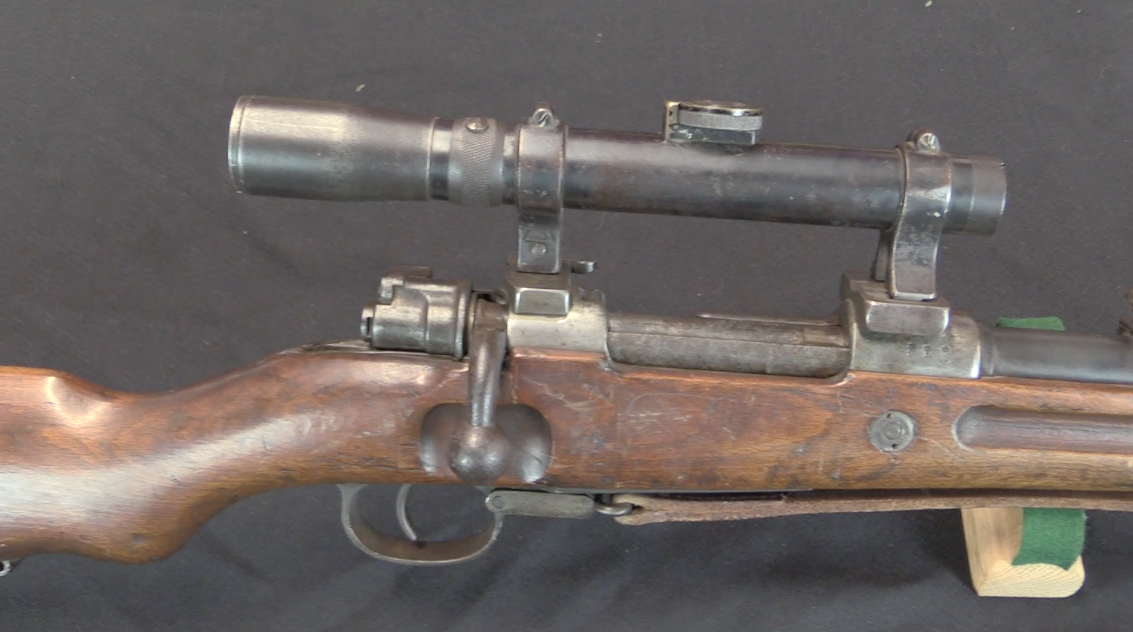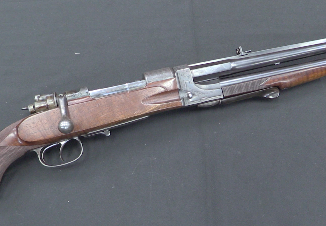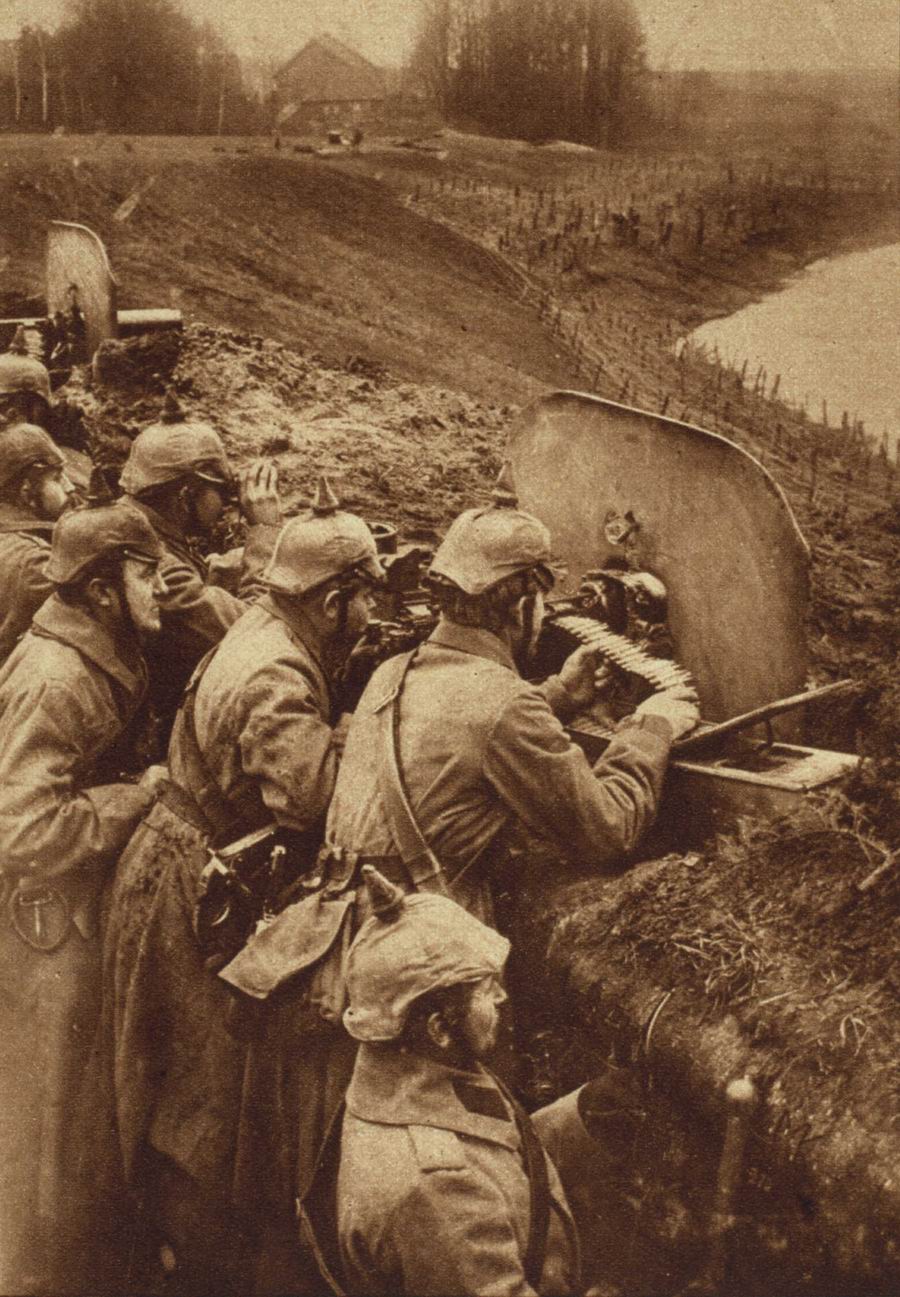Throughout the pre-WWI period, Paul Mauser was working continuously to develop a reliable self-loaiding rifle. Among his many experimental designs was a flapper-locked rifle. The flapper-locking system was first patented by a Swede named Kjellman, but his design (for a light machine gun) did not get beyond prototype form. Mauser made a military rifle using the system, and also scaled it down to handgun size as a potential followup to the C96 “Broomhandle” Mauser.
This handgun was designated the 06/08, and used the same basic layout as the C96, with the magazine located in front of the grip. About a hundred were made, and they all used detachable magazines, with examples being made from 6-round to 20-round capacity.
The action was a short-recoil one, locked by a pair of flaps inside the rear. The flaps would pivot out of contact with the bolt as the action recoiled, and then the bolt would be able to slide back between them (very similar to the Soviet DP/RPD/DShK lone of machine guns, actually). This example is a gorgeously refinished on, with a 20-round magazine.




This pistol should be the forerunner of Mauser 1910/14 philosphy. It is striker fired, uses two piece safety, one for “on”‘, other for “off”, and a slide stop mechanism using magazine follower for “stop” and an empty or loaded magazine for “release”. Its construction seems not straight minded like C96. It has all seperate, striker, recoil and barrel extention return springs and looks like a shrinked auto rifle with receiver inside recoiling breechbolt. A good carbine could be made through of its construction.
Kj ins Swedish is like Ch in Cherub
You have to wonder: 1) Why the 9 mm Mauser Export cartridge didn’t see more use. It provides a lot of power in pistols and SMGs both. 2) Why the broomhandle layout isn’t still in fashion. Those old irons hang well and point well, and you can build them to handle potent fodder. The pistol is this excellent video would get my money if it was in current production. Is that just me? Doubt it!
The C/96 type layout was the basis for practically every SMG that didn’t have side-feeding magazine. Lay a C/96 alongside the receiver of a Thompson SMG, you’ll see what I mean. The 1980s and later Interdynamics KP-9 “Jammamatic” even used it. As did several of the lesser-known WW2 U.S. SMGs, such as the Hyde Model 35, the Ingram Model 6, and the UD42, plus such European ones as the French MAS38 and MAT49, the Beretta Model 12, the Belgian Vigneron, and of course the Czech Skorpion “machine pistol”.
The PRC even put the Model 711/712 versions of the C96 back into production in the late 1980s as the Type 89. Still in 7.63 x 25mm (well, they called it 7.62, as in “Tokarev”), with a slightly-curved 20-round detachable box, still with a detachable shoulder stock, and wonder of wonders a leetle tiny bayonet on its 5″ barrel. (Why, no one seems to know.) They were mainly used by “militia”, i.e. local police.
As for the 9 x 25mm, as I said on the Bren Ten thread, it’s probably the best all-around police service pistol cartridge ever concocted, whether you call it the “9mm Mauser Export” or the “9mm Winchester Magnum”.
The Russian 9 x 21mm comes close to it, as for that matter did Jeff Cooper’s old “9mm Super round”, which had the small drawback that it would chamber in a 9 x 23 Largo (Bergmann-Bayard Long) chambered pistol, which wasn’t really up to handling its pressures (above .38 Super levels). The 9 x 25 would solve such problems the same way a .357 Magnum round will not enter a properly-cut .38 Special chamber.
cheers
eon
“9 mm Mauser Export cartridge didn’t see more use.”
Hungarian Danuvia 39.M sub-machine gun is chambered for 9x25mm cartridge.
http://hungariae.com/Danu39.htm
My theory is that the 9MM Mauser Export was ahead of it’s time, more comparable to the .30 M-1 carbine round in use and less comparable to the 9MM Parabellum. It was a pistol-carbine cartridge, about 60/40 weighted to carbine use, while the Luger and the 9mm Parabellum were pistols first, carbines second, maybe you could call the ratio about 80-20 weighted in favor of the pistol. The Germans when they accepted the P-08 left the provision for a stock for specialist purposes but not true carbine use. Then belatedly they got religion and produced 70-30 weighted in favor of carbines with the artillery model but of course immediately procured every C96 they could get their hands on even in 7.63 although they also ordered 9mmP’s later. Then the issue was military necessity…..the submachine gun which was a whole different Meghila found itself replacing pistol carbines with a pistol round, to which the 9/mm Mauser Export was not quite suited. In short it was ready too early for when it was needed. The US and Brits were married to pistols for short range use only with short rifles also being carbines. Italy and France were married to carbines firing the service cartridge with rifles.
Then the US adopted a clumsy but incredibly effective semi-auto rifle. However it as it was a clumsy bitch, they determined the need for a near pistol caliber cartridge for utility use (which expanded greatly). I wonder if the 9mm Mauser Export C96’s might have had a place in US thinking. Then again no other country was interested until it discovered how useful the little baby carbine was and started getting them from the Americans….. Of course the Chinese had found the pistol-carbine ideal for Chinese style fighting, but they were limited on their sources and utilized, quite effectively the 7.63 Mauser cartridge, as did the Russians. The impact of the 7.63 Mauser cartridge has been enormous. The 9mm Export an also ran but only because it was betrayed by unlucky timing.
The broomhandle layout is everywhere. There is a phlethora of selective fire submachine guns and assault rifles whose layout can be traced back to the C96 concept. Modern handguns still ascribe themselves to the short range only firing philosophy so front magazines are just not needed.
However, there is hope. With the advent of new tech, perhaps Hans Solo’s blaster might prove prophetic.
Ed: My best guess is that the decline of the broomhandle type is entirely a question of compactness. With the magazine in the butt you have one protuberance not two. With the magazine farther back you get a shorter over-all length for the same barrel length. Good reasons? Well, not entirely perhaps, but the industry has not been entirely guided by good reasons. Perhaps another, stronger reason is that the broomhandle layout at some point started to look old fashioned.
I have no idea why some cartridges become popular and adopted by militaries and become world standards, like the 9mmP, and others end up obscure.
That may be true for pistols, but the C96 layout is good for pistol-caliber automatic weapons, as eon has pointed out. Most SMGs or machine pistols feeding through the grip seem to have some sort of “manhandling problem” during a firing cycle should there not be a fore-grip included in the stock. In the case of the C96 and most SMGs with a vertically feeding magazine in front of the trigger group (and I’m assuming the magazine is below the barrel), a user should be able to use the magazine well as a grip (don’t grab the mag itself during a shooting or the gun will jam).
Am I wrong?
The ideal situation is a design with a “sleeve” firmly attached to the receiver that the shooter can grasp without “canting” the magazine forward or backward. The Argentine MEMS SMG family probably did it better than anyone else;
http://weaponland.ru/_ph/7/2/219661927.jpg
Note the later model had a stamped pistol grip and magazine well that were shaped like a 1911A1 grip, right to the arched “mainspring housing”.
With most conventional pattern SMGs, the “grab the mag well” grip is about the only practical way to hold it. Those who try to fire by holding the front of the receiver above the mag well (as German troops were taught with the MP40), or by the barrel jacket (as on the Sten MK II) are generally asking for lightly grilled fingers on the off hand. The Thompson, with its horizontal forearm and and/or vertical foregrip, was one of the few that had a reasonably well-thought out way to hold the forend and control the weapon in burst fire.
cheers
eon
“I have no idea why some cartridges become popular and adopted by militaries and become world standards, like the 9mmP, and others end up obscure.”
Cartridge success (or falling into oblivion) is very strong related to success of fire-arms which fire it, if it gain success then cartridge will be popular [see .30-30 Winchester Center-Fire and Winchester Model 1894 for example].
Other factor is that it is or is not redundant to cartridge just in production [see .32 Winchester Special redundant to .30-30].
Newer cartridge must heavily out-perform existing to gain success (9×19 often replaced revolver cartridge designed yet in 19th century, which were less powerful than 9×19 [see .380/200 Revolver round in British service Enfield No. 2 which was replaced by Inglis High-Power])
It wa an good idea to make an automatic carbine with a powerfull cartridge.
So cool pistol.
I’m not understand why not was an succesfull gun. ¿More complicated than the c96?
This great flap locked pistol evolved into the Mauser 1912-14 and the rifle Mauser Selbslader that you showed us before. https://www.forgottenweapons.com/early-automatic-pistols/mauser-191214/ https://www.forgottenweapons.com/early-semiauto-rifles/mauser-selbstlader/ The use of the clip to lower the slide was a Mauser standard feature from the 1910, 1914 1934 to the HSC. Thanks for your work.
Does the bolt have enough (over)travel distance to let the spring catch the bolt rather than the C96’s dead stop and jerk the muzzle up? Any idea why they didn’t make/sell more than 100ish?
There are a few clues as to why they never came to anything. At least one had a cracked receiver, (this one being a very early 1906 version, so they might have sorted out the problem later,) indicating that the ammo was too powerful for the frame. DWM also listed four or five different 9mm Export cartridges during this development period, all with slightly different lengths and weights, indicating that the cartridge itself was giving trouble. Very few examples of the pistol survive, perhaps indicating a certain fragility, and of those that do, none have been proof-marked, (someone correct me if I’m wrong – my source is an article written about 25 years ago). It seems reasonable to conclude that the project was more trouble than it was worth to Mauser and the lessons learned went into more successful designs. Although Mauser pursued flapper-locking like a dog with a bone, it can’t have been very economical to apply this complexity to a handgun.
I suppose that the “chamber upon insertion of magazine” idea seems to be slightly faster than “depress slide release after having inserted a new magazine.” If I were a guy in the trenches, the former approach would be speed for necessity under fire while the latter is a more secure way of reloading without the possibility of faulty feeding. Which is better?
The best was probably that of the Mauser M1910/34 pocket auto. An internal slide lock, released by simply pulling the slide back and letting it run home, chambering a round from the top of the newly-inserted loaded magazine as it went.
The Walther PP and PPK used a similar setup. The P.38, by comparison, had an external slide lock similar in concept if not in shape to that of the 1911, and that eventually became the default for all newer designs.
Parabellums (Lugers) can be confusing. The 1900 model holds the toggle open with the magazine follower, like a Mauser 98 rifle. This makes removing the magazine difficult, and when it comes out just an eighth of an inch or so, the toggle slams shut; very disconcerting if you’re not expecting it.
The P.08 has an internal toggle catch like the slide catch on a Mauser M1910. Except that wartime ones often don’t have it due to production shortcuts. They act like the 1900.
Then there’s the Martz Safe Toggle Release developed by John Martz. The toggle locks open on the last shot, held by an internal catch. You insert a fresh magazine, and apply the safety, down and back as per standard P.08 practice. When the safety hits bottom, it trips the toggle catch, closing the breech on a fresh round with the pistol now “Gesichert”. (“Made safe” in German, the word found engraved on the frame of P.08s that is exposed when the safety is applied.)
The best solution with a P.08, IMPO, is carry the dratted thing “Condition Three”; loaded magazine, empty chamber, and yank the toggle up and back real hard on the draw. Avoids a lot of confusion.
Better yet, get a less confusing sidearm.
cheers
eon
Mauser 06/08 slide stop follows in same way what M 1910/34 works. Mauser’s US Patent, 903 988 describes it clearly. The magazine follower holds the breechbolt open after last shot and transmits the task to the specially designed two functioned ejector with a cost for slightly forwarded breechbolt. When an empty or loaded magazine inserted, its back pushes the ejector out of engagement with breechbolt and it goes forward. In case of a loaded one inserted, canted front of ejector slightly pushes the top cartridge to the chamber to match with the initial forwarding of breechbolt and released same to load the barrel. Difficult job in this process is, the need of some power to withdraw the empty magazine from the spring forced breechbolt at beginning of the process.
It really seems like, for the time, this would have had an amazing amount of firepower for it’s size and weight, especially if a stock and select fire capability were added. For this to have been available years before the great war, in which the most common small arms were bolt action rifles and revolvers, really kind of illustrates just how much resistance there was to progress in small arms technology.
“For this to have been available years before the great war, in which the most common small arms were bolt action rifles and revolvers, really kind of illustrates just how much resistance there was to progress in small arms technology.”
Considering long-arms:
In years before Great War development was focused on elongating range, this lead to creating following cartridges: 7.92×57 Mauser, 7×57 Meunier, .276 Enfield, 6,5×57 Fyodorov which feature high muzzle velocity; self-loading rifle were developed aswell – French Meunier, Russian Fyodorov – but with war raging on adopting new cartridge and/or rifle was not feasible as it would hamper logistic.
Considering hand-guns:
Hand-guns are always low priority for any military forces, as there are many more important weapons systems (battlecruisers, cannons, howitzers, aeroplanes and others) which will render army outclassed equipment-wise – revolver-armed army is not woefully outclassed by army using automatic pistols.
What a neat, well thought out pistol. My wife, who’s fond of the “Steampunk” genre, soooo wanted to bid on this one…..till we saw the expected price range.
please shoot with the Mauser 06/08 !!!